Infrared Imaging
Infrared imaging is a very common safety, security, surveillance, and intelligence-gathering imaging technology. Although the infrared (IR) range is large, from about 700 nm (near IR) to 1 mm (far IR), the STG addresses those IR bands of the greatest importance to the safety and security communities. These bands (shown graphically in Figure 1) are the near IR (NIR, about 750 nm to 1.5 μm), typically used for perimeter/site/building security, both indoor and outdoor; and the long-wave IR (LWIR, about 7 μm to 15 μm), typically used in outdoor security applications, long-range surveillance and intelligence gathering, and firefighter applications. NIST is developing the metrology to establish objective test and evaluation protocols for these imagers and, in collaboration with the University of Texas – Austin, possibly developing new objective image quality metrics, and develop methods for correlating these new metrics or traditional image quality metrics to human task performance.

Discussion: LWIR: TIC results: BRFL, NVL, UT-Austin
The Security Technologies Group, in collaboration with other researchers at NIST, developed a generic protocol to correlate certain image quality indicators with the ability of human operators to perform perception-based tasks. This protocol was applied to the thermal (or long-wave infrared) imaging cameras (TICs) used by firefighters. There are many applications for TICs, and each may have a unique set of image quality metrics. Therefore, we focused on the 85 % or greater use case, which is the identification of hot spots behind wall board, concealed under carpeting and rugs, and concealed by fabrics. {need more}
Discussion: MWIR: U Houston results
In collaboration with other researchers at NIST, the US Army Night Vision and Electronic Sensors Directorate, and the University of Houston’s Computation Physiology Lab, we developed protocols to measure the correlation between stress and observable changes in MWIR.
PUBLICATIONS
- T.R. Goodall, A.C. Bovik, N.G. Paulter, “Tasking on Natural Statistics of Infrared Images, (link is external)” IEEE Transactions on Image Processing, Vol. 25, No. 1, January 2016, pp. 65 to 79.
- T.R. Goodall, A.C. Bovik, H. Vikalo, N.G. Paulter, “Non-uniformity Correction of IR Images using Natural Scene Statistics (link is external),” 2015 IEEE Global Conference on Signal and Information Processing (GlobalSIP), 13 to 16 December 2015, Orlando, FL.
- J.R. Jendzurski, N.G. Paulter Jr., “Image Quality Testing: Selection of Images for Assessing Test Subject Input,” 8th International Conference on Sensing Technology, Liverpool, UK, 2 to 4 September 2014.
- F.K. Amon, D.D. Leber, N.G. Paulter Jr., “Objective evaluation of imager performance (link is external),” Proceedings for the International Conference on Sensing Technology,” Palmerston North, NZ, 11 Nov to 1 Dec 2011.
LINKS
- On infrared spectra and technical applications
- UT – Austin’s Laboratory for Image and Video Engineering
- US Army’s Night Vision and Electronic Sensors Directorate
- National Fire Protection Association (NFPA)
- NFPA documentary performance standard for thermal imaging cameras
- University of Houston’s Computation Physiology Lab
Contacts
-
(301) 975-8009

